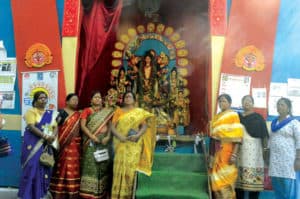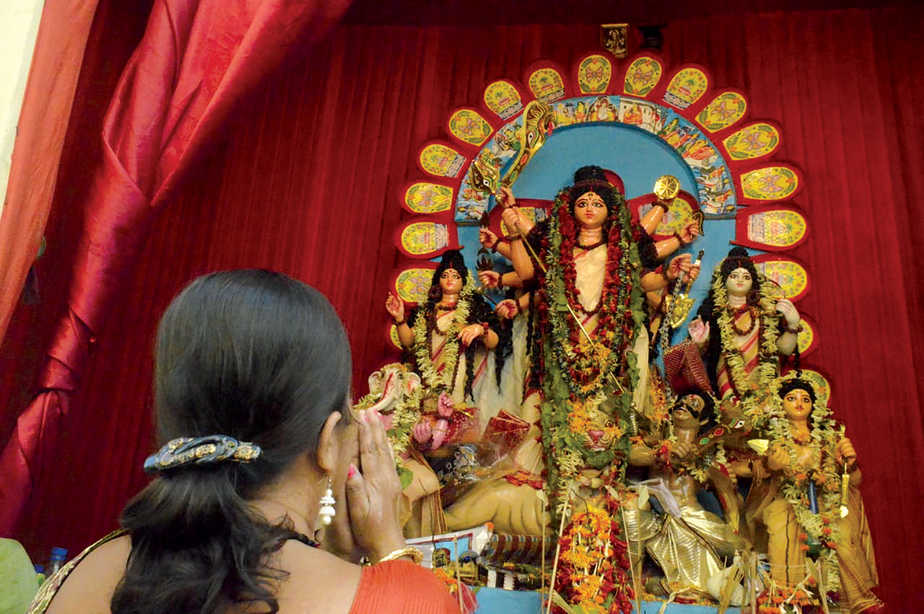The lanes of Kolkata’s Sonagachi, Asia’s largest red-light area, come alive during Durga Puja as the sex workers organise a one-of-a-kind puja with festive fervour
Payal (name changed) is a busy woman during Bengal’s biggest festival, Durga Puja. She does everything from arranging fruits for the puja to dancing during the immersion celebration. Then she goes back to work — as a prostitute in Asia’s biggest red-light area, North Kolkata’s Sonagachi.
Since 2013, the Durbar Mahila Samannay Committee — an organisation that works for the welfare of sex workers — sets up a Durga Puja organised by sex workers right in the heart of the flesh trade at Sonagachi. “We are also part of Bengali society and we too, want to be involved in all the festivities,” says Kajol Bose, the secretary of the puja committee and an active sex worker.
Sonagachi is situated in a prime location in Kolkata, surrounded by heavyweight pujas like Ahiritola, Baghbazar, Beniatolla and Md Ali Park. “We were never allowed to enter the premises of the pujas, let alone take part in the festivities,” says Bose.
“Whenever we used to enter the puja premises, and the organisers found out that we are involved in the flesh trade, they would drive us out,” she says, adding that this is the reason why the community decided to have a Durga Puja of their own.
The festivities for the community begin even before Sasthi (sixth day of Durga Puja). “We have an opening ceremony on the day of Choturthi, followed by a cultural programme on Panchami. The programme is performed by members of the community and also by our children, who too are looked down upon by the society,” she says. On the day of Ashtami — the eighth and the main day of the festival — the members of the community prepare a bhog (meal) of khichdi made with with 300 kg of rice and dal, a mixed vegetable curry and paayesh (Bengali sweet). “We distribute the bhog to different red-light areas across the city,” says Bose.

But it was not always easy. They had to face many challenges, especially in the beginning. “Our puja moved to the main road only in 2017. Before that we were forced to organise it in a small 8×6 ft room in one of the houses of Sonagachi. “When we first approached the authorities with the proposal of organising a puja, we faced hurdles at every small step,” says Bose. “The police refusedto grant us permission on the main road, without citing any reason, and the municipalities also did not allow us to construct a temporary structure, so we were forced to organise our puja in the confines of a small room,” she adds.
“We filed a petition in the Kolkata High Court, so that we could get all the necessary permits from the authorities and do a large-scale puja on the road, like any other neighbourhood in Kolkata. Finally, after a three-year long legal battle, the Supreme Court finally granted us permission and in 2017, we organised a grand puja,” says Bose.
Currently, around 500 sex workers in the area are actively involved in the puja. “We have around 12,000 workers here, who come regularly and attend the puja, but since our demand is the highest during this festive season, a lot of the girls don’t get enough scope to participate as they also have to work to keep their stomachs full,” says Bose.
The sex workers at the Durbar are not the only ones who participate in the puja. A large chunk of the LGBTQ community too, is an integral part of organising the festivities. The puja is the first committee in the city to feature a trans-woman as the brand ambassador on their official banner.
The society, according to Bose, has started accepting them as a part of the normal society. “People throng in large numbers every night during the puja days, and they also accept our prasad and other offerings. Even Ahiritola Jubak Brinda, one of the renowned pujas in Kolkata, has featured the life of the sex workers of Durbar as the theme of their puja this year,” she says.
However, the acceptance has not come at a very basic level. “People still object when we pronounce the Durga chants in loudspeakers, as the locals complain that we cannot chant the name of the goddess through our unholy mouth,” says a dejected Bose.
“Durga Puja is a celebration of the feminine power. However, as women, we have faced so many difficulties in conducting the puja and continue to face hurdles. Ironically, according to the customs, the first layer of clay that is applied to make the idol is to be taken from the home of a prostitute,” says Bose. “Even though we now conduct the puja much more peacefully than when we started, we still have a long way to go before society accepts us fully,” concludes Bose.





